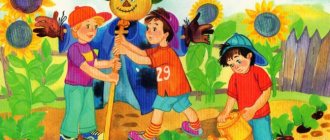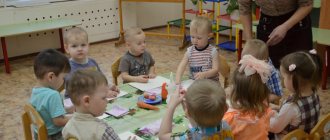Typically, kindergartens teach children 3-4 years old. Working in specialized programs, teachers give young preschoolers there the entire set of knowledge and skills they need. But there are also situations when a child cannot attend this institution or misses a lot due to frequent illnesses. Then the parents take charge of their child’s education themselves. Through systematic developmental activities for children 3-4 years old, even at home, children can learn everything that is appropriate for their age, if you know what and how to teach them.
How educational activities are carried out with children 3-4 years old at home
Homeschooling is a labor-intensive process that requires certain preparation of the parent and the right attitude. To work effectively, you need not only to think through the content of the lessons, but also to awaken the child’s interest in learning. What do you need to know?
Principles of organizing home activities
Any training, home or professional, must be carried out in accordance with the basic principles of pedagogy and take into account the age characteristics of the preschool child. What do you need to know?
- Firstly, for 3-year-old children the leading activity is play. Only by playing can a child be completely immersed in the learning process and firmly grasp the necessary knowledge.
- Secondly, all activities with the child must be systematic. Daily lessons, which are planned in advance, become more difficult as they are learned.
- Thirdly, the child’s activities should constantly change - alternate mental stress with physical exercise and creative tasks.
Conditions for conducting “lessons” for preschool children
At 3 years old, children are already able to concentrate for a long time on an object that interests them, and yet you should not plan too many tasks. The duration of classes for children 3 years old should be no more than 25 minutes, with a mandatory dynamic pause.
Thematic material:
- Educational games for 3 year old boys
- Games for girls 4 years old - educational
It is better to start work when the child has had time to rest and is in a good mood; they usually do it after breakfast or nap, every day at the same time.
While working, nothing should distract the baby’s attention - remove everything unnecessary from the table and out of sight.
Use bright props, handouts and manuals. You can buy them or make them yourself. To avoid losing interest in these learning tools, try not to play with them outside of class.
It’s good if all the exercises in the lesson are united by one plot. This will make it easier to keep the child’s attention.
Take a break from mental stress through physical exercises - dancing to music, walking along a line and an incline, playing with a ball, etc. They need to be included in every lesson.
Objectives and planning
The effectiveness of any work, including pedagogical work, depends on correctly set tasks and a clear plan for their implementation.
The main objectives of developmental activities for children 3-4 years old include the following:
- formation of thinking skills;
- development of motor skills, imagination and creativity;
- improving the sound and semantic aspects of speech, expanding vocabulary;
- formation of ideas about the phenomena and properties of objects, the surrounding world;
- education of personal qualities, teaching norms of behavior.
It is necessary to draw up a plan of developmental activities for children from 3 years old so that different types of activities alternate. Weekly planning will help you understand which exercise should be left, which one should be made more difficult, and which one should be put off for a while.
The principle of constructing classes for preschoolers
All classes for preschool children are based on the principle of playful learning and development. Children better assimilate information that is presented to them unobtrusively, in the form of a game.
Classes should be conducted after a night or daytime sleep - this is the very time when the preschooler is ready to learn new material. The duration of classes should not exceed 25 minutes.
For classes, you need to prepare props, make a plan and think through a scenario. It is better if all the exercises in one lesson are united by a common plot. This could be a certain fairy-tale hero who comes to visit the baby and needs help. The latter helps the guest solve problems and find a way out of the situation, simultaneously learning the material and the necessary knowledge.
Games for children 4 years old
Game 13. “I don’t see and I don’t hear”
This is a great outdoor game for two or more players that children really enjoy. Rules: when the presenter says “I don’t see,” the players run, jump, frolic, but in absolute silence. If someone makes a sound, they lose. If the presenter says “I don’t hear,” then the players can and should make noise, shout, sing, laugh, but stand in one place. Whoever moved lost.
The game is more suitable for the street, so that children can run around and shout to their heart's content without disturbing the neighbors.
Game 14. “Colored paints”
This is a great game for reinforcing knowledge of colors and their shades. It requires a minimum of three participants.
We are sure many parents will remember the rules! You need to draw a line (or lay a rope or cord), on one side of which the leader stands, and on the other, the players. The presenter turns his back, names any color and turns back. Whoever has this color on their clothes easily crosses to the other side, but the rest of the participants must run across before the leader grabs them. Which player he caught takes the place of the leader.
Game 15. “Obstacle Course”
This game will require a little preparation, as you need to create “difficulties” that the children will overcome. It is best to play in a group or even in teams for speed.
Focusing on the interests of the baby, create an obstacle course (chairs to crawl under, a tunnel of pillows, leaves that will save you from a lava river, and so on). The theme can be different, for example, hunting dinosaurs, rescuing a princess from a dragon, a jungle, a pirate island and any other fantasy.
If teams are playing, you can prepare a main prize for the winners and an incentive prize for the losers. But the most important reward in the “Obstacle Course” will be a great mood and a boost of energy!
Game 16. “Again and Again”
An excellent game that develops classification and analysis skills.
You will need cards with pictures of animals, plants, furniture, flowers, transport and anything else that can be classified.
The essence of the game is to lay out all the pictures in front of the child, for example, with furniture and ask them to separate small objects from large ones, then wooden ones from plastic ones, and so on. The more options you have to analyze and compare, the better.
Game 17. “What’s in your mind?”
The purpose of the fun is to develop attention, auditory perception, and speech in a fun and interesting way.
Prepare several simple pictures with different contents and ask your child to choose one, but do not say which one. Then the adult asks questions to figure out which image was chosen, and the child answers either yes or no. For example: “There is a person in this picture?”, “Is there yellow in the person’s clothes?” Then switch roles - who will complete the task faster?
Ready-made plot pictures or images of animals can be purchased at any bookstore or made yourself by cutting them out of magazines.
Game 18. “Mysterious actions”
Two or more people play and need to understand what the presenter is showing with his gestures or actions. For example, an adult pinches his nose, closes his eyes and squats - this is diving into the water. You can wish for any real objects or activities: writing, swimming, sleeping, hammering, and so on. The presenter can prepare possible options in advance and write them down on cards. The participant who named the correct answers faster than the others wins.
Game 19. “Who can do that?”
Another interesting game for speech development. The task is simple - to guess what is being said faster than other players. The presenter describes an object, person or character, for example: “This is a small metal object that makes a thin sound. Such small objects are often hung around the neck of pets” (bell).
The game helps to consolidate any acquired knowledge: about professions, transport, plants, animals, seasons and many other objects and phenomena.
Game 20. “Comparisons”
An adult shows the child two objects and asks them to tell what their similarities and differences are. For example: “Here is a ball and a balloon of different colors, compare them!” The similarity is that both objects are round in shape. Differences: color, material. The more signs the baby names, the better. Gradually make the task more difficult by selecting similar objects, for example, cubes of the same color, but slightly different in size. You can also increase the number of items being compared.
This game perfectly develops attention and improves classification and analysis skills.
Repeat the pattern
Identical pictures
Two identical objects
Game 21. “Questions and answers”
The essence of the game is to answer various questions asked by an adult. These can be either funny questions or educational and reinforcing ones. For example: “Are there thunderstorms in winter?”, “What color is the sun?” or “Why do you need to eat?”
The game develops speech and memory, as well as generalization skills and is suitable for quiet family evenings.
Game 22. “Teams”
An interesting, calm game for speech development. The presenter prepares funny commands in advance: “Sit down, those who love compote,” “Close one eye, those who drank juice today,” and so on. Fun is suitable for meeting new people because it allows you to get to know the interests of new friends and create a fun atmosphere.
Game 23. “Signals”
A very interesting game that develops attention and increases concentration, and also improves memory. The task is simple - the presenter prepares “signals” in advance (any cardboard figures of different colors) and shows them to the children. Each color denotes some action, for example, yellow - stand still, red - sit down, blue - raise your arms up. Show these signals to the players in random order. Gradually make the task more difficult and say commands by showing cards of a different color. The winner is the one who is not confused and follows the signals correctly.
Game 24. “Collecting toys”
An excellent active game that helps not only develop attention and memory, but also quickly clean the room! It is advisable that there are at least two participants in the game to make it a competition.
Take a few items and place them around the room in different places (or just verbalize what to look for). Children need to find all things as quickly as possible and put them in a drawer or basket. The one who comes first wins.
Then make the task more difficult and suggest continuing the search by standing on one leg, clapping, walking single file, or crawling.
What objects were in the picture?
Games for children 3 years old
Game 1. “Trap”
Take a skein of thick thread and, together with your child, build a “trap” - threads stretched in different directions, like a spider’s web. You can attach small bells in different places of the “net”. The players' task is to get through the trap without hitting the threads and the bell. If this task seems simple, make it more difficult and play for speed! Prepare a small prize for the fastest and most nimble participant.
Children really like this game; it does not require careful and lengthy preparation; you can play it both at home and on the street.
Game 2. “What’s in your palms?”
You will need 15-20 small objects (chips, sticks, badges, cubes, circles) of three colors that are already familiar to the child.
The task is simple - having hidden the thing in your hand, we ask: “Not yellow or blue, which one?” If the child answers correctly, the item goes to him; if not, it remains with the presenter. The one who collects the most trophies wins. You can deliberately confuse the baby, call other colors and characteristics, for example, shape and size, use not three, but 4-5 colors. Focus on your child’s knowledge and be sure to change roles so that your child is the leader.
This game helps consolidate knowledge of colors, develops attention and observation, and teaches analysis.
Game 3. “Who has it?”
A good game for developing speech, observation, and consolidating knowledge. The adult lists the objects, and the child names who they may belong to. For example: “Who has a ladle, an apron, a knife and a cap?” (cook) or “Who has a big shell and small legs that can’t run?” (turtle).
Game 4. "Trains"
This fun, active game is suitable for those children who do not like competition.
Invite them to pretend to be a train, lining up one behind the other. The essence of the game is to repeat all the movements after the first player, who can walk straight, jump from place to place, turn in different directions, walk backwards, dance, and so on. Make sure that everyone can become a helmsman.
This game is best played outdoors, but if there are few children, it is also suitable for a home environment.
Game 5. “Monkeys”
Another game for repetition of movements. But it involves facial expressions more than the body.
Tell the kids that monkeys love to make faces and repeat movements one after another. Invite children to be these animals and play! Let one child repeat the movements of an adult or come up with grimaces himself, and all the other players repeat after him. Don't forget to change the leader or play in pairs if there are many children.
Game 6. “Height”
A great idea for playing outdoors and at home. Prepare a rope or cord and lay it out in a line. This will be your road over the abyss. At the end of the cord, place a plate or box containing a prize (an apple, a lollipop, a ball or any other pleasant surprise). The baby’s task is to carefully walk along the rope, maintaining balance and without falling. While your child is trying to pass the test, encourage him with words, let him feel the support of the fans! It’s even more interesting to play with teams for speed. If everyone copes easily, make the path over the abyss not straight, but winding.
This game develops baby's coordination and also brings a lot of fun and good mood!
Game 7. “Magic threads”
This is a great game for developing imagination, as well as consolidating knowledge about colors and shapes. Show how to use threads or laces of different colors to lay out the outlines of various objects and shapes. And then offer to lay out the sun, a flower or a house, a cloud or the outline of a bird yourself, first in one color, and then in several.
Game 8. “Rain”
Another option for playing with threads or laces. Together with your child, draw clouds on thick cardboard. Underneath them, using scissors or an awl, make small holes through which the child must thread threads or lace to create short stripes of rain stitches.
Game 9. “Funny grains”
An excellent option for developing fine motor skills, imagination, and sensory perception. The task is simple - pour semolina or any other small grain into a flat dish or tray in a thin, even layer.
Then invite your child to draw familiar shapes and designs on such a “canvas” with his finger. At the beginning these will be simple images: a house, the sun, a cloud, and then you can complicate the task.
When your baby gets a little older, use this game to learn letters and become familiar with numbers.
Game 10. “Cobwebs”
Take a cardboard box and make several holes in each of its sides. Then invite your child to weave a web by threading multi-colored threads through the resulting holes. Use threads or laces of different thickness, color and length. You can diversify the game by simply placing small objects at the bottom of the box. When the web is ready, use tweezers or your fingers to remove the remaining items from the bottom of the box.
Game 11. “Guess”
The essence of the game is to guess with your eyes closed what the host put in your hand. Select small objects of different shapes and different materials. If the child speaks well, invite him to voice his thoughts, for example: “This is something wooden, rough, hard and with sharp corners. I think it's a cube."
Remember the picture
Guess the sound
Game 12. “Curly searches”
The task is simple - cut out geometric shapes from paper of different textures (plain, cardboard, metallized, velvet, newspaper): circle, square, triangle, rectangle, oval. Then blindfold your baby and ask him to use his fingers to find all the circles or other shapes. For children 4 years old, you can prepare more complex options (polygons, trapezoids, rhombuses).
Knowledge and skills of children 3-4 years old
A preschooler aged 3-4 years already has a certain experience and set of knowledge. Typically at this age children are able to:
- distinguish and name colors;
- count to 10;
- collect simple puzzles from 4 - 6 parts;
- remove excess items according to specified characteristics;
- see and name inconsistencies;
- memorize easy poems.
When developing a scenario for a lesson with a preschooler, these nuances should be taken into account. Too simple exercises will not arouse interest in the baby, and complex ones, in addition to misunderstanding, can provoke a protest.






